Creative Weight-Bearing Activities for Seniors: From Dance to Gardening
As we age, maintaining **bone density** becomes crucial for our health. Weight-bearing exercises are a fundamental way to strengthen bones, enhancing stability and reducing fracture risks. For seniors, engaging in fun activities not only provides physical benefits but also boosts mental health. Creative alternatives are essential when considering exercise routines, as they can motivate older adults to stay active. One promising approach is incorporating dance into a fitness regimen. Dance can be a delightful way to exercise, fostering social interaction while promoting movement. Zum-ba, line dancing, or simple ballroom can provide an adaptable pace, accommodating various fitness levels. Furthermore, activities like gardening have proven beneficial for maintaining bone density. Gardeners engage in lifting, bending, and stretching, all of which are weight-bearing actions. Planting or tending to flowers encourages mobility and encourages outdoor activity. Participation in these types of activities contributes significantly to overall wellness. Practicing these weight-bearing exercises regularly helps in preserving not only bone density but overall well-being, making the golden years enjoyable and fulfilling.
Dancing: The Joy of Movement
Incorporating **dance** as a fun way to maintain bone density is becoming increasingly popular among seniors. Various styles cater to different preferences and mobility levels. From ballroom to tap and line dancing, the joyful expressions allow for both physical work and social connection. Dance classes specifically designed for seniors encourage gentle movement while improving balance and coordination. For instance, consider **joining a local community class** or participating in online platforms that offer instructions for seniors. Furthermore, dancing encourages musical appreciation and boosts mood levels due to endorphin release. Choosing dance forms that allow individual creativity is essential, as it fosters ownership in the activity. Even at home, pairing up with a partner or family member to dance can initiate spontaneous fun. Dance not only enforces weight-bearing movements but also adds vibrancy to life. Furthermore, as dance sessions are generally social, they benefit one’s mood and mental health, addressing loneliness and isolation, particularly in older adults. Making movement joyful and enjoyable helps foster a commitment to exercise, establishing a solid foundation for lifelong habits.
Another exciting weight-bearing activity for seniors is gardening, which can be adapted to suit any ability level. Working in the garden involves various tasks, like digging, planting, and weeding, all of which are physical actions that contribute to bone strength. Notably, the joy of nurturing plants adds emotional satisfaction, creating a wholesome activity that rejuvenates the spirit. Seniors can practice specific exercises while gardening, such as deep squats when planting bulbs. Furthermore, leveraging raised beds can minimize the strain on back and joints, making gardening accessible to all. Additionally, community gardens foster social interaction and provide an opportunity to connect with peers. Engaging with fellow gardeners promotes camaraderie, enhancing mental and emotional well-being. Incorporating light weights into garden activities can amplify the benefits, making them more effective. Moreover, spending time outdoors contributes to vitamin D synthesis, essential for calcium absorption, further helping in bone health. This guarantees that gardening, combined with socialization and sunlight, becomes a valuable part of a senior’s physical activity repertoire, promoting longevity and health.
Walking: A Simple Yet Effective Exercise
Walking is arguably one of the simplest yet most effective forms of exercise available to seniors. This weight-bearing activity significantly contributes to **bone density**, cardiovascular health, and overall well-being. Choose to walk in local parks or neighborhoods to enjoy nature while fostering connections within the community. Utilizing walking groups encourages motivation, safety, and sociability for those who may have limited mobility. **Walking sticks or poles** can be introduced to enhance stability and provide assistance, empowering seniors to walk longer distances. Small changes, like opting for stairs instead of elevators, can integrate walking into daily routines easily. Regular walking sessions can also be paired with stretching exercises to ensure flexibility and strength, aiding in balance control. Moreover, walking can be an excellent opportunity for older adults to connect with loved ones or engage in mindfulness practices, enhancing their emotional well-being. Integrating music or audiobooks can further improve the walking experience, making each session more enjoyable. Overall, walking proves a convenient choice for weight-bearing exercises, fitting seamlessly into everyday life for seniors.
Strength training is another vital component of a well-rounded fitness regimen, supporting bone density among seniors. Adaptable exercises focusing on major muscle groups, such as squats, lunges, and resistance bands, can be introduced into daily routines. Light weights or even body-weight exercises provide excellent benefits while ensuring safety. For seniors looking to begin, it is imperative to consider working with a fitness instructor specializing in senior fitness. Proper guidance helps create individualized plans tailored to students’ needs, ensuring exercises are performed safely. Incorporating strength training along with dynamic movements helps improve functional stability and supports the act of daily living. Exercising consistently can lead to visible results, such as increased mobility and reduced pain, fostering independence in older adults. Seniors can also undertake group classes to promote a sense of community and accountability, preventing feelings of isolation. Additionally, strength training encourages social interaction, which is paramount for emotional and mental health. As confidence builds through strength training, seniors can gradually increase resistance or weights, fostering a lifelong passion for fitness and well-being.
Yoga: Mindfulness and Movement
Yoga offers a beautiful blend of mindful movement and relaxation, making it a valuable practice for seniors. This form of exercise greatly supports bone density and flexibility, helping to maintain balance and strength. Yoga classes designed for older adults provide a safe space for individuals to explore various styles at their own pace. It emphasizes breathing and relaxation; incorporating profound focus often results in decreased stress levels. Furthermore, gentle poses and movements can primarily benefit individuals with mobility restrictions, ensuring inclusivity. **Chair yoga** provides a wonderful option to perform stretches while seated, perfect for seniors who may struggle with balance issues. The calming environment fosters emotional stability, addressing anxiety and depression among older adults. Practicing regularly cultivates discipline and routine, essential components of physical health. Additionally, engaging in yoga classes creates bonds among participants, fostering social well-being. Whether following a video at home or attending local classes, this practice’s accessibility and benefits are unmatched. The integration of mindfulness during yoga enhances both physical and mental resilience, encouraging seniors to discover joy in movement and relaxation.
In conclusion, seniors have a variety of creative weight-bearing activities available to enhance bone density and overall health. **Temporary trends** may come and go, yet the importance of physical activity in our lives remains constant. By exploring options like dancing, gardening, walking, strength training, and yoga, older adults can find personalized methods that resonate with their interests and lifestyles. Adopting a multi-faceted approach improves the chances of maintaining dedication to exercise, fostering stable routines that yield substantial benefits. Importantly, ensuring peer engagement strengthens the sense of community which supports emotional health. Family members can encourage their loved ones by promoting these activities, making the process enjoyable. Consultation with healthcare providers can further guide suitable exercise routines for seniors, thereby making safety a priority. Ultimately, maintaining **bone health** is achievable through fun, engaging activities that instill a sense of purpose and improve quality of life. Each elderly individual can embrace fitness creatively, ensuring that their golden years are marked by vitality and joy. With consistency and enthusiasm, the path to a healthier lifestyle becomes most rewarding.


